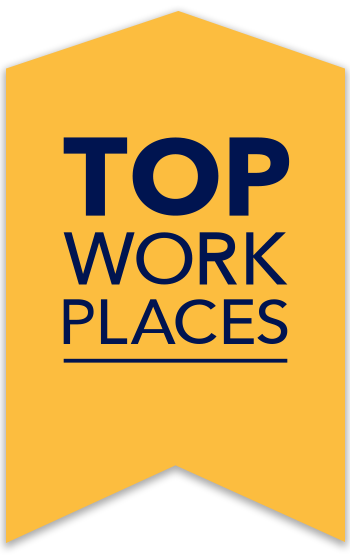The Energage people science and data team recently released results from over 240,000 employee surveys showing that nearly 40 percent of participants often feel overwhelmed and experience burnout at work. Even worse, only 64 percent believe their company cares about it.
And what’s more alarming? This statistic represents employees at Top Workplaces and those that aspire to reach this status. So even among the strongest workplaces cultures, employees are struggling with burnout.
Employee burnout is dangerous because it causes people to put their energy toward getting through the work day rather than thinking forward. If unchecked, it will spread like wildfire, leading to business disruptions, higher turnover rates, and stunted company growth. Learning how to help someone with burnout will protect your employees and the future of your business.
Beating burnout at work requires identifying root causes, changing habits, and asking leadership to set the tone. Knowing the warning signs of burnout, how to deal with it, and who is responsible can help your organization tackle the root causes of burnout.
Identifying workplace burnout
Burnout at work can include emotional, mental, and physical symptoms such as:
- Exhaustion
- Headaches
- Fatigue
- Productivity loss
- Anxiety
- Inability to focus
- Mental distance
- Irritability
- Emotional fragility
It’s important to note that identifying employee burnout is not always an easy task, especially when warning signs also look like a bad attitude, laziness, or personal problems. Additionally, burnout may be caused by life outside work.
The pandemic, the current state of the world, and new hybrid working models are leading to employees working longer hours with a higher chance of burnout. Even though it may be tricky, monitoring employee burnout is more critical than ever because it’s one of the top reasons why employees quit.
Learn more: Causes of Low Productivity
Seven strategies to deal with workplace burnout
Prevention is the best-case scenario to minimize the spread of employee burnout. It’s such a contagious issue that it can sneak up in unexpected ways, no matter your prevention strategy.
There are several ways to get ahead of burnout, no matter your cause or industry. Follow these steps to figure out how to help employees with burnout, improve well-being, protect your culture, and keep your company moving forward.
1. Have employees take burnout diagnostic tests
One way to identify burnout on an individual level is to run diagnostic tests. From manager to employee, these assessments open the door for communication and give management a gauge on burnout levels.
Here are some of the standard tests:
It can be intimidating for employees to share their feelings, especially with the stigma around burnout symptoms. Giving them consistent opportunities to share feelings and getting managers interested in the process will boost morale, productivity, and profitability.
On a company level, employee engagement surveys — such as the research-backed Workplace Survey — can identify burnout at work symptoms and capture anonymous feedback about employee well-being.
2. Encourage managers to check in with employees often
People spend most of their waking hours at work. And their manager has the most significant impact of everyone they interact with. That means it’s essential that managers care about their employees as individuals and show genuine interest in their goals and concerns. When managers care, they have an easier time creating an environment of trust and mutual respect.
Aspiring organizations are companies striving to become Top Workplaces. Those who compete generally have stronger-than-average cultures.
Energage research shows that 86 percent of employees at aspiring organizations responded positively to the Concerns statement on the Workplace Survey. These are organizations that are striving to become Top Workplaces. Those who compete generally have stronger-than-average cultures. At Top Workplaces, the number jumps to 90-97 percent.
And this matters. Research shows that employees are 62% less likely to experience burnout if their manager is willing to listen to their work-related problems. Managers can take an active role in their employees’ mental health by having weekly or monthly check-ins.
3. Reset job expectations with employees
Employees are more likely to experience burnout if they feel they are working too much or have unclear job expectations. Managers must reevaluate employee workloads with the individuals to ensure job expectations are reasonable and clear.
Managers should consistently check in with employees to see how they feel about their role and identify any roadblocks to performance. Additionally, managers should keep an eye out for employees trying to achieve too many different things or having difficulty prioritizing their time, as they are more likely to burn out.
4. Implement an employee assistance program
Setting up employee resource programs and providing trained professionals to help with any issues can address employee burnout. This can include employee assistance programs, counseling, mental health programs, personal coaches, and wellness programs.
Supporting employees with the right resources starts with capturing their feedback on what can make the most significant impact. EAPs will show your company how to recover from burnout and prevent it from happening again.
Learn more: Creating an Employee Well-Being Strategy
5. Offer rewards
Rewarding employees for their contributions will boost engagement and motivation more organic way. Getting creative with employee rewards can help employees to feel valued and appreciated. Just be sure to separate these from performance-based incentives.
Here are some ideas to consider:
- Schedule no-meeting days to give employees time to catch up
- Encourage employees to take advantage of vacation days
- Offer bonus vacation hours
- Host optional mindfulness events
- Offer free snacks at the office or have them delivered
6. Keep track of workplace culture
Workplace culture is a hot topic, and for a good reason. Many emotional and mental health issues stemming from burnout are directly related to a toxic workplace culture or bad culture fit.
Ideas that can improve company culture and prevent employee burnout include:
- Knowing the warning signs of employee burnout.
- Insulating employees from toxic clients or customers.
- Offering flexible work schedules.
- Respecting boundaries to encourage work-life balance.
- Ensuring job roles and expectations are clear.
- Reducing time pressure whenever possible.
7. Use compassion and empathy to solve problems
Compassion and empathy go a long way to minimizing employee burnout. Avoid jumping to conclusions when employee performance is slipping. Instead, open 1:1 communication with them to understand what is happening and how you can help.
Good managers know that providing employees with a compassionate, empathetic, honest, and safe space to talk will help them understand what’s really going on. Employees who feel heard are more likely to speak honestly and share what could improve the situation. Nurturing these relationships can also improve engagement.
Types of workplace burnout
While most burnout symptoms are similar, they can have different root causes and necessary solutions. Here are three types of employee burnout:
- Overload burnout is common and occurs when someone works at an unsustainably high pace.
- Under-challenged burnout results from boredom or feeling underappreciated. It typically happens when employees don’t have enough to do.
- Neglect burnout happens when employees aren’t given enough guidance and cannot keep up with job demands. This type of burnout is interrelated with employee engagement.
Take burnout seriously
Employee burnout is a significant threat to your company, including higher turnover, decreased productivity, and poor customer service. Efforts to prevent burnout and improve employee well-being are most effective when practiced across the organization. Here are several tips to consider:
Leaders:
- Show enthusiastic support for well-being and be an active participant.
- Advocate for budget allocation and well-being policies.
- Model work-life flexibility to show it’s a culture priority.
- Empower managers to be flexible.
- Advocate away from long work hours.
Managers:
- Discuss employee needs and address workload issues.
- Model healthy work-life flexibility.
- Encourage employees to take PTO.
- Set realistic deadlines and foster open dialogue with employees.
- Show employee appreciation genuinely and consistently.
Employees:
- Speak up early and become a fierce self-advocate.
- Utilize available resources and take advantage of PTO.
- Actively participate in company social events.
- Take advantage of employee assistance programs and other resources.
Top Workplaces take employee well-being seriously, and they get recognized for their efforts. Eliminating employee burnout and being intentional about preventing it can improve employee retention, culture, and engagement — not to mention making the world a better place to work together.
See the Top Workplaces for Employee Well-Being awards
If your company is proud of its employee well-being initiatives, get recognized for it! Nominate your organization for Top Workplaces, the employer recognition program that offers awards in 60+ regional markets and national awards for culture and industry excellence.

